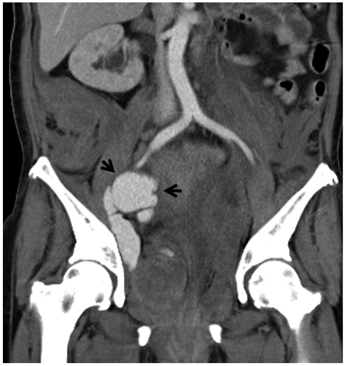Yonsei Med J.
2011 Mar;52(2):358-361. 10.3349/ymj.2011.52.2.358.
Abdominal Compartment Syndrome Due to Spontaneous Retroperitoneal Hemorrhage in a Patient Undergoing Anticoagulation
- Affiliations
-
- 1Department of General Surgery, Seoul St. Mary's Hospital, College of Medicine, The Catholic University of Korea, Seoul, Korea. cmckji@catholic.ac.kr
- KMID: 1779676
- DOI: http://doi.org/10.3349/ymj.2011.52.2.358
Abstract
- Spontaneous retroperitoneal hemorrhage is one of the most serious and often lethal complications of anticoagulation therapy. The clinical symptoms vary from femoral neuropathy to abdominal compartment syndrome or fatal hypovolemic shock. Of these symptoms, abdominal compartment syndrome is the most serious of all, because it leads to anuria, worsening of renal failure, a decrease in cardiac output, respiratory failure, and intestinal ischemia. We report a case of a spontaneous retroperitoneal hemorrhage in a 48-year-old female who had been receiving warfarin and aspirin for her artificial aortic valve. She presented with a sudden onset of lower abdominal pain, dizziness and a palpable abdominal mass after prolonged straining to defecate. Computed tomography demonstrated a huge retroperitoneal hematoma and active bleeding from the right internal iliac artery. After achieving successful bleeding control with transcatheter arterial embolization, surgical decompression of the hematoma was performed for management of the femoral neuropathy and the abdominal compartment syndrome. She recovered without any complications. We suggest that initial hemostasis by transcatheter arterial embolization followed by surgical decompression of hematoma is a safe, effective treatment method for a spontaneous retroperitoneal hemorrhage complicated with intractable pain, femoral neuropathy, or abdominal compartment syndrome.
Keyword
MeSH Terms
Figure
Reference
-
1. Pode D, Caine M. Spontaneous retroperitoneal hemorrhage. J Urol. 1992. 147:311–318.
Article2. Chan-Tack KM. Fatal spontaneous retroperitoneal hematoma secondary to enoxaparin. South Med J. 2003. 96:58–60.
Article3. Curry PV, Bacon PA. Retroperitoneal haemorrhage and neuropathy complicating anticoagulant therapy. Postgrad Med J. 1974. 50:37–40.
Article4. Hodin E, Dass T. Spontaneous retroperitoneal hemorrhage complicating anticoagulant therapy. Ann Surg. 1969. 170:848–851.
Article5. Bhasin HK, Dana CL. Spontaneous retroperitoneal hemorrhage in chronically hemodialyzed patients. Nephron. 1978. 22:322–327.
Article6. Fernandez-Palazzi F, Hernandez SR, De Bosch NB, De Saez AR. Hematomas within the iliopsoas muscles in hemophilic patients: the Latin American experience. Clin Orthop Relat Res. 1996. (328):19–24.7. Heim M, Horoszowski H, Seligsohn U, Martinowitz U, Strauss S. Ilio-psoas hematoma--its detection, and treatment with special reference to hemophilia. Arch Orthop Trauma Surg. 1982. 99:195–197.
Article8. Torres GM, Cernigliaro JG, Abbitt PL, Mergo PJ, Hellein VF, Fernandez S, et al. Iliopsoas compartment: normal anatomy and pathologic processes. Radiographics. 1995. 15:1285–1297.
Article9. McCort JJ. Intraperitoneal and retroperitoneal hemorrhage. Radiol Clin North Am. 1976. 14:391–405.10. González C, Penado S, Llata L, Valero C, Riancho JA. The clinical spectrum of retroperitoneal hematoma in anticoagulated patients. Medicine (Baltimore). 2003. 82:257–262.
Article11. Sasson Z, Mangat I, Peckham KA. Spontaneous iliopsoas hematoma in patients with unstable coronary syndromes receiving intravenous heparin in therapeutic doses. Can J Cardiol. 1996. 12:490–494.12. Sugrue M. Abdominal compartment syndrome. Curr Opin Crit Care. 2005. 11:333–338.
Article13. McNelis J, Marini CP, Simms HH. Abdominal compartment syndrome: clinical manifestations and predictive factors. Curr Opin Crit Care. 2003. 9:133–136.
Article14. Hunter JD, Damani Z. Intra-abdominal hypertension and the abdominal compartment syndrome. Anaesthesia. 2004. 59:899–907.
Article15. Moore AF, Hargest R, Martin M, Delicata RJ. Intra-abdominal hypertension and the abdominal compartment syndrome. Br J Surg. 2004. 91:1102–1110.
Article16. Dabney A, Bastani B. Enoxaparin-associated severe retroperitoneal bleeding and abdominal compartment syndrome: a report of two cases. Intensive Care Med. 2001. 27:1954–1957.
Article17. Vayá A, Mira Y, Aznar J, Todolí J, Arguedas J, Solá E. Enoxaparin-related fatal spontaneous retroperitoneal hematoma in the elderly. Thromb Res. 2003. 110:69–71.
Article18. Andrade MM, Pimenta MB, Belezia Bde F, Xavier RL, Neiva AM. Abdominal compartment syndrome due to warfarin-related retroperitoneal hematoma. Clinics (Sao Paulo). 2007. 62:781–784.
Article19. Dondelinger RF, Trotteur G, Ghaye B, Szapiro D. Traumatic injuries: radiological hemostatic intervention at admission. Eur Radiol. 2002. 12:979–993.
Article20. Merrick HW, Zeiss J, Woldenberg LS. Percutaneous decompression for femoral neuropathy secondary to heparin-induced retroperitoneal hematoma: case report and review of the literature. Am Surg. 1991. 57:706–711.
- Full Text Links
- Actions
-
Cited
- CITED
-
- Close
- Share
- Similar articles
-
- A Case of Spontaneous Retroperitoneal Hemorrhage due to Iliopsoas Muscle Hematoma in Patient with Myocardial Infarction Receiving Intravenous Heparin
- Spontaneous Retroperitoneal Hematoma due to Liver Cirrhosis: A Case Report
- Suspected abdominal compartment syndrome during endoscopic diskectomy: A case report
- Case of Abdominal Compartment Syndrome Treated by using a Bedside Open Linea Alba Fasciotomy
- The Occurence of Deep Vein Thrombosis in Abdominal Compartment Patient



